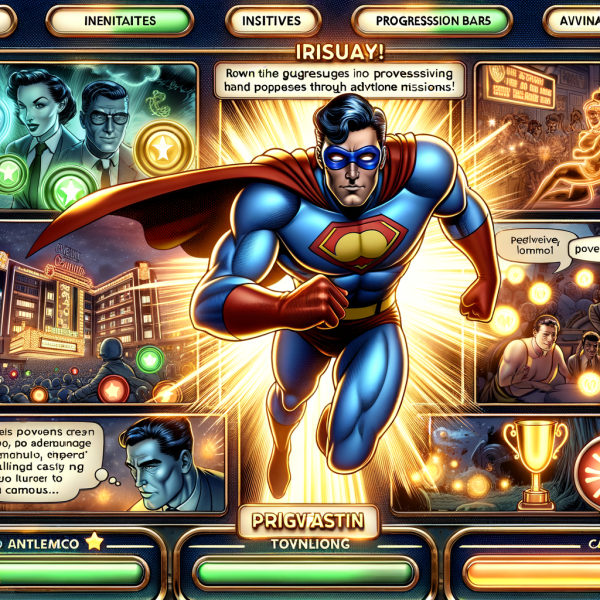The Rise of Gamification in Online Casinos Explained
In recent years, online casinos have undergone a significant transformation, leveraging technology to enhance user experience and engagement. One of the most prominent trends in this evolution is gamification, which integrates game-like elements in non-gaming contexts. This approach aims to captivate players by making the gambling experience more interactive, rewarding, and enjoyable, thereby increasing loyalty and retention rates.
Gamification encompasses a variety of strategies, including leaderboards, rewards systems, and achievement badges, designed to create a more immersive environment. Online casinos are increasingly adopting these techniques to differentiate themselves in a saturated market, where competition for player attention is fierce. By transforming traditional gambling into a multi-layered gaming experience, casinos can cultivate a sense of community among users and encourage prolonged engagement.
Moreover, the rise of mobile technology has fostered an environment conducive to gamification. With players increasingly accessing online casinos through smartphones and tablets, operators can utilize app-based features to enhance the gaming experience. Dynamic notifications, real-time updates, and interactive challenges can be pushed through mobile platforms, ensuring that users remain engaged even when they are not actively playing.
As the online gambling landscape continues to evolve, understanding the role of gamification becomes crucial for casinos looking to not only attract new players but also retain existing ones. The integration of game mechanics into online gambling signifies a shift towards a more engaging and player-centric approach, setting the stage for the future of user engagement.
Enhancing User Experience Through Game Mechanics
The deployment of game mechanics in online casinos is primarily aimed at enhancing user experience. Features such as quests, levels, and challenges engage users by providing them with clear goals and a sense of accomplishment. For instance, a player might be tasked with completing a series of challenges over a week to earn bonus credits or free spins, which not only incentivizes play but also keeps the experience fresh and exciting.
Additionally, the use of point systems allows players to track their progress and rewards. This creates a tangible connection between the player’s actions and the benefits they receive, which can lead to increased satisfaction. By implementing visual cues such as progress bars and achievement notifications, online casinos can effectively motivate users to continue playing, fostering a deeper emotional connection with the platform.
Moreover, social features integrated into gamification strategies—like sharing achievements on social media or competing against friends—can enhance user engagement on a community level. This communal experience encourages players to invite friends, thereby expanding the casino’s user base while simultaneously making the experience more enjoyable.
Lastly, providing real-time feedback through gamified elements can significantly improve user experience. Instant rewards, such as small bonus credits for completing tasks, keep players engaged and encourage them to explore more of what the platform has to offer. This feedback loop not only enhances user satisfaction but also helps casinos to better understand player preferences and behaviors.
| Gamification Element | Purpose | Example |
|---|---|---|
| Leaderboards | Foster competition | Top players ranked for rewards |
| Badges | Reward achievements | Earn badges for milestones |
| Quests | Enhance engagement | Complete tasks for bonuses |
| Point systems | Track progress | Earn points for gameplay actions |
Psychological Triggers: Why Gamification Works Effectively
Gamification thrives on understanding psychological triggers that motivate players. The concept of “loss aversion,” for example, posits that individuals prefer to avoid losses rather than acquire equivalent gains. By incorporating elements that allow users to feel they might lose something they have (like points or bonuses), casinos can drive higher engagement. This principle encourages players to continue playing to maintain their status or rewards.
Another critical psychological trigger is the “variable reward” system, reminiscent of a slot machine’s unpredictability. By offering players intermittent rewards, casinos can create a sense of excitement and anticipation, increasing the likelihood of repeat visits. This unpredictability mirrors the thrill of gambling itself, making gamified features more attractive to users.
Social validation also plays a crucial role in gamification’s effectiveness. Users often seek social acceptance, and features such as sharing achievements or competing in leaderboards cater to this need. When players can share their victories or see how they stack up against their peers, they are more likely to engage repeatedly with the platform to maintain or improve their social standing.
Lastly, the concept of “self-determination theory” suggests that individuals are motivated when they feel autonomous, competent, and connected to others. Gamification can address these needs by offering players agency in their actions, opportunities to improve their skills, and connections with other players. By meeting these intrinsic psychological needs, online casinos can cultivate a highly engaged user base.
Case Studies: Successful Gamification Strategies in Action
Several online casinos have successfully implemented gamification strategies, demonstrating its effectiveness in enhancing user engagement. For example, a prominent online gaming platform introduced a “lifetime achievements” feature, where players earn badges for milestones such as time spent playing, games tried, and wins achieved. This simple yet effective strategy significantly increased user retention, as players aimed to collect all available badges, fostering a sense of accomplishment and loyalty.
Another successful case is an online casino that leveraged leaderboards to create competitive weekend tournaments. By allowing players to compete for the top spots and win substantial cash prizes, the casino witnessed a marked increase in player activity during weekends. This strategy not only attracted more users but also kept existing players engaged, as they vied for recognition and rewards within the community.
Furthermore, a mobile casino app integrated a “missions” feature, where users could complete daily or weekly tasks to earn points. The missions varied from playing specific games to inviting friends. This initiative led to a significant uptick in user engagement, as players were motivated to log in daily to complete tasks and claim rewards, enhancing not only individual playtime but also the casino’s overall user base.
Lastly, some casinos have adopted storytelling elements within their games, allowing players to embark on adventures as they progress through levels. This narrative approach creates emotional investment, drawing players into the game world and encouraging them to continue playing to uncover more of the story. Such strategies have proven effective in not only retaining players but also in attracting new ones intrigued by the immersive experiences offered.
Challenges and Risks in Implementing Gamification
While gamification offers numerous advantages, it is not without its challenges and risks. One significant concern is the potential for over-gamification, where the introduction of too many game elements can overwhelm users rather than enhance their experience. Finding the right balance between engagement and simplicity is critical; otherwise, players may feel discouraged or frustrated, leading to decreased participation.
Additionally, online casinos must navigate the regulatory landscape surrounding gambling. In some jurisdictions, gamification features may be scrutinized under gambling regulations, particularly concerning responsible gaming practices. Operators must ensure that their gamification strategies do not promote excessive gambling behaviors, as this could lead to legal repercussions and damage their reputation.
Another challenge is the risk of alienating non-gamified players. Some users prefer traditional gambling experiences without the complexities of game mechanics. If online casinos focus too heavily on gamification, they may inadvertently push away a segment of their audience who may feel overwhelmed or uninterested in these features.
Lastly, the implementation of gamification requires a thoughtful approach to design and development. Poorly executed gamification elements can result in confusion and disengagement. Therefore, ongoing testing, user feedback, and adjustments are essential to ensure that the features resonate with users and contribute positively to the overall experience.
The Future of User Engagement: Trends to Watch For
Looking ahead, several trends in gamification are poised to shape user engagement in online casinos. One prominent trend is the integration of virtual and augmented reality (VR/AR) technologies. These technologies can create highly immersive environments, allowing players to experience gambling in a more realistic setting. As VR/AR becomes more accessible, online casinos that leverage these technologies will likely stand out in the market.
Moreover, the personalization of gamified experiences is expected to become increasingly sophisticated. Through data analytics and machine learning, casinos can tailor challenges, rewards, and promotions to individual user preferences. By providing a personalized experience, casinos can foster deeper emotional connections with players, enhancing loyalty and engagement.
Gamification strategies will also increasingly emphasize social interaction. Features that allow players to form teams, compete against one another, and engage in collaborative challenges will become more prevalent. As social gaming continues to gain traction, incorporating these elements into online casinos will be essential for maintaining competitiveness.
Lastly, responsible gambling will remain a significant concern, and gamification can play a role in promoting safe play. By incorporating features that remind players of their gambling habits, offering self-exclusion options, and providing resources for responsible gambling, online casinos can use gamification to support user well-being while still engaging them effectively.
Q&A Section
Q1: What is gamification in online casinos?
A1: Gamification in online casinos involves incorporating game-like elements into the gambling experience to enhance user engagement, satisfaction, and retention.
Q2: What are some common gamification elements used in online casinos?
A2: Common gamification elements include leaderboards, achievement badges, quests, point systems, and social features like sharing achievements.
Q3: Why does gamification work?
A3: Gamification works by leveraging psychological triggers such as loss aversion, variable rewards, social validation, and the need for autonomy and competence.
Q4: What are the risks of implementing gamification?
A4: Risks include over-gamification, regulatory concerns, alienating non-gamified players, and the potential for poorly executed features that could disengage users.
Q5: What future trends should we expect in gamification for online casinos?
A5: Future trends include the integration of VR/AR technologies, personalized experiences, enhanced social interaction, and a focus on promoting responsible gambling.





I think gamification sounds interesting, but I’m not sure how it will change online casinos for regular players. It seems like there are a lot of new things to learn.